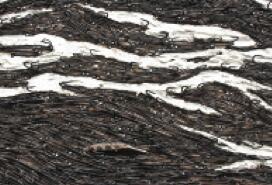Yoan Capote
Jack Shainman, New York
I have followed the development of Yoan Capote’s work from his participation in the 8th Havana Biennial (2003) to his first solo exhibition last fall at the Jack Shainman Gallery. Mental States consisted of paintings, works on paper, sculpture, photographs, video, and intervened found objects. This mature work revealed a defined sense of aesthetics, extraordinary craftsmanship, and engaging conceptual modes.

Isla (See-scape), the largest painting in the exhibition, is a tour- de-force. The four panels are made by thickly applying oil paint to jute and inserting 800,000 fish hooks into the surface to create an illusionistic scene of turbulent water highlighted by light and dark areas. The expansive view of water against a distant horizon recalls the time-honored subject of seascapes in academic painting (for example, Winslow Homer’s High Tide, 1870). Contemporary depictions of water have engaged artists seeking to express spiritual, ecological, and geographical aspects of life’s most vital element (recall Maya Lin, Pin River – Hudson, 2009). Water and boats, sometimes with human figures, have also been metaphors for travel, escape, and exchange by Cuban artists of the two previous generations. Capote, who lives in Cuba where he was born and raised, has childhood memories of looking out to sea and imagining what the United States was like beyond the horizon: for the artist it was both alluring and “dangerous.” Fish hooks, after all, intended to ensnare and capture prey, evidently reference the contentious political realities marking relations between Cuba and the United States for more than half a century.
American Appeal (Postcard) of 2004–2010 and American Appeal (Aerial) of 2009–2010 were also made with thousands of fish hooks attached to the thick oil-painted surfaces. The depiction of buildings facing the East River, as well as those in the aerial view, was adopted from postcards sent to the artist prior to his first visit to New York City in 2002.
In making these works, the artist was assisted by a close group of collabora- tors, and, interesting enough, the fish hooks were made on a 19th-century machine once used for manufacturing them. In addition to Capote’s predilection for employing unusual materials in a repetitive way, he realized that the act of inserting fish hooks was easier than removing them. Thus the materials provided a means to communicate his attachment to Manhattan. The sea, the horizon, and space are also elements in other works in this exhibition. Historical Fatalism (Past and Future) is a video installation with two monitors placed side by side. The video, shot from a corner inside a destroyed building in the Miramar neighborhood of Havana, follows a laborer as he clos- es up the opening for a window by placing bricks in the form of an American flag. In the other monitor, the laborer removes the bricks, again revealing a view of the sea. In this labor- intensive, time-based performance, the video footage alternates between color and black and white, one symbolizing the future, the other, the past—no doubt a nod to Jasper Johns, but also to openness and closure, to possibilities and impossibilities, to hope and its denial, to the future and the past.
One of several successfully executed and thought-provoking sculptures is Migrant (2010), featuring the feet and legs of a man metamorphosed with the roots of two trees and their trunks. The sculpture was placed on the floor with the man’s boots facing up. The preparatory drawing, by contrast, showed the man’s legs suspended from the ceiling, allowing for another installation option. Deracination, a traumatic reality for peo- ple around the globe, haunts our collective imagination, and Capote, drawing on surrealist modes, comments inventively. Capote’s reflections on history—past and present—sexuality, and political conditions are humorous, serious, often ironic. Mental States was a gratifying viewing experience.





